DINKY 106 THUNDERBIRD 2 (1974-1980):
UPDATED: 9th OCTOBER 2018
Dinky replaced its very popular 101 Thunderbird 2 with an re-designed version. It was slightly larger and had sturdier legs but was coloured blue unlike the 101 which was green. Instead of keeping the same catalogue number it was presumably deemed sufficiently different to justify a new number 106. Opinion is divided as to whether it was a better or worse model than its predecessor.
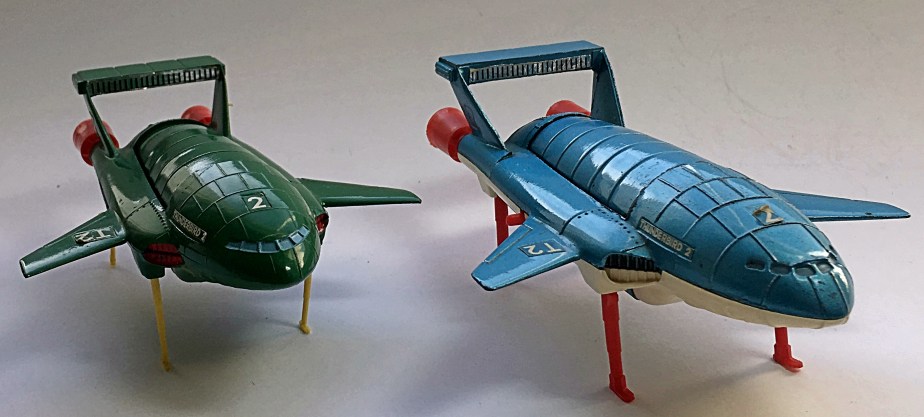
Why a blue colour? In the authorised biography of Gerry Anderson (Simon Archer/Marcus Hearn) Gerry was visiting the Dinky factory and was surprised to see hundreds of blue 106’s rolling off the production line. When he asked the MD why blue, the answer was that they had done market research that showed that children did not like green toys. The Thunderbirds TV Series production had ended in 1966 and so its also probable that the colour match with the original TV prop was not important to the kids that bought the model.
During the 6 year production run, the model was released in a number of variants finally emerging with a white plastic underside as Dinky Toys headed towards closure.
DINKY 106 THUNDERBIRD 2
The first 106 was produced in metallic blue with yellow legs, this information based on the 1975 catalogue illustration, and was all metal.





Thunderbird 2 came with a detachable pod containing a plastic Thunderbird 4. The pod door was black.

THUNDERBIRDS TV SERIES:
Considered to be Gerry and Sylvia Andersons’ most popular and commercially successful series, Thunderbirds was a British science-fiction television series filmed by their production company AP Films (APF).

It was produced between 1964 and 1966 using a form of electronic marionette puppetry (dubbed “Supermarionation”) combined with scale model special effects sequences. Two series were filmed, comprising a total of thirty-two 50-minute episodes and additionally two feature films were made.
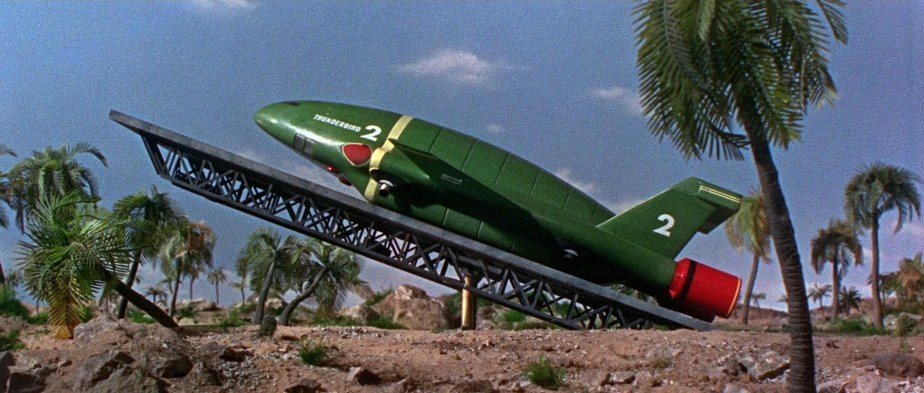
The TV series was set in the mid-2060s and followed the exploits of International Rescue (IR), a life-saving organisation equipped with technologically-advanced land, sea, air and space rescue craft; these were headed by a fleet of five vehicles named the Thunderbirds and launched from IR’s secret base in the Pacific Ocean. The main characters were ex-astronaut Jeff Tracy, the founder of IR, and his five adult sons, who piloted the Thunderbird machines.
TV PROP v DINKY MODEL:
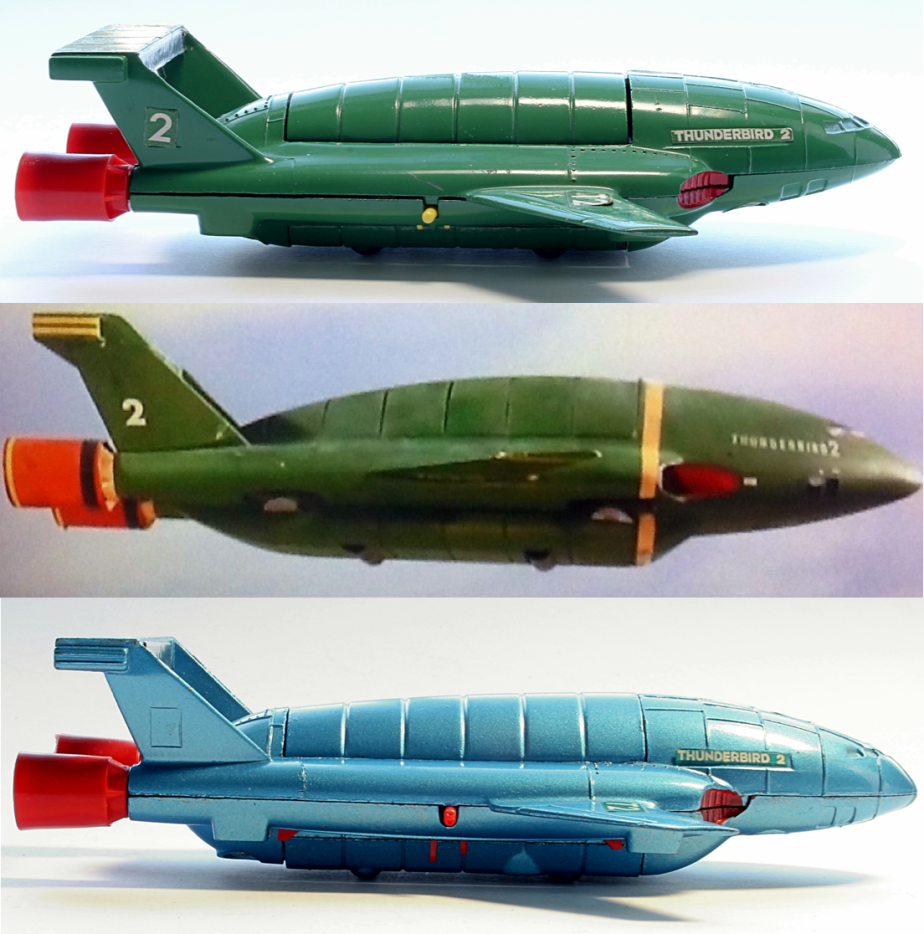
VARIANTS:
The first all blue version also came with red legs

The second variant had a black plastic base with either yellow or red legs.

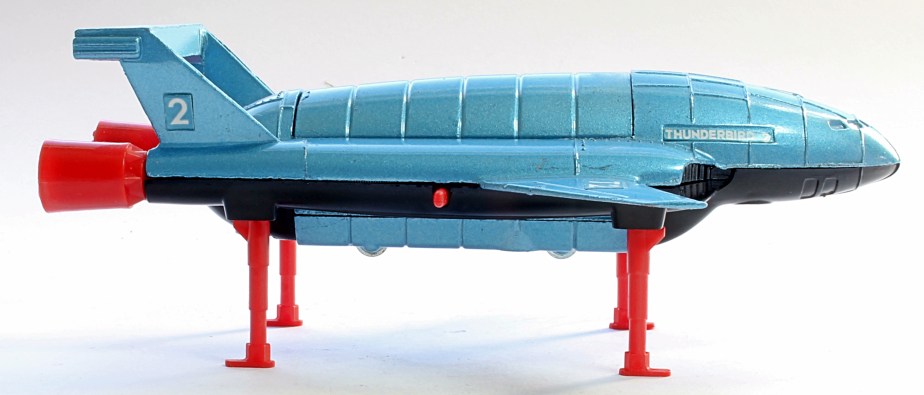


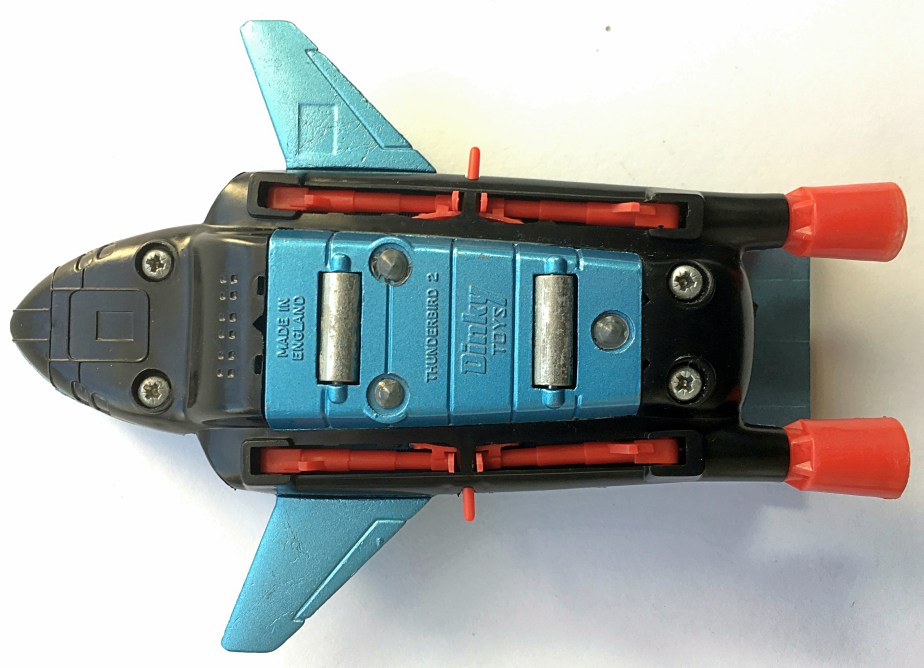
The black base with yellow legs version. Some version of the plastic bottom based variants left the factory without the tail engine intake stickers.

The third and final variant had a white plastic base. This model usually had red legs but a reliable NZ collector has provided pictures of this variant with yellow legs. If anyone else has this variant please let me know as this is the first one I’ve seen. The rear thruster inserts were yellow/red. Very little, if any, chrome finishes were being made at this stage of Dinky’s existence. Some models were sold without the stripy engine intake stickers on the rear wing.



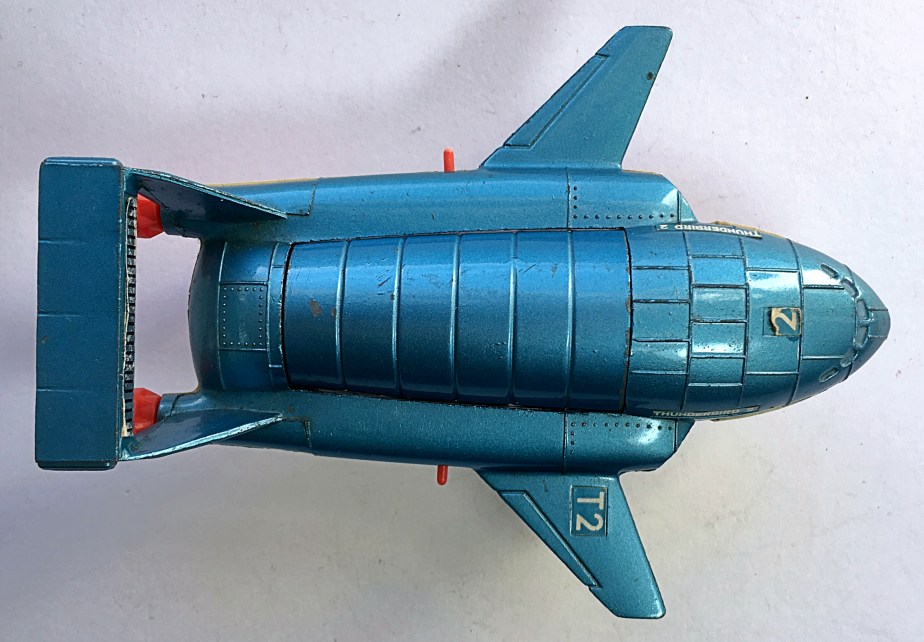

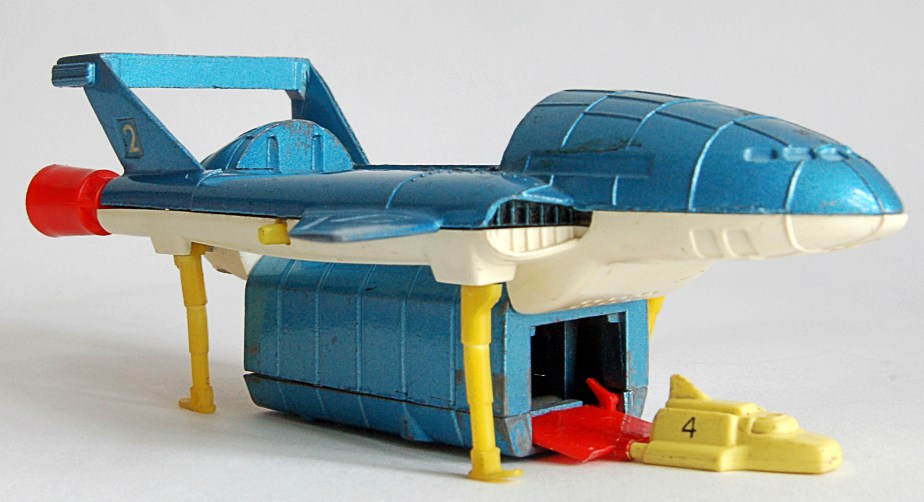
PODS:
The 106 had two pod door colours, red or black. These can obviously be interchanged but from research its likely that the all metal blue base version came with only black doored pods. The black base version with yellow legs always had a black door pod and the red legged version could have a black or red pod door. The white base version could have either a red or black door.

All the 106 Thunderbird 2’s.


DINKY 101 v 106 THUNDERBIRD 2:
The key difference, apart from the colour, between the 101 Thunderbird and the redesigned 106 version was the size. The 101 was 143mm long and the 106 was 153mm.
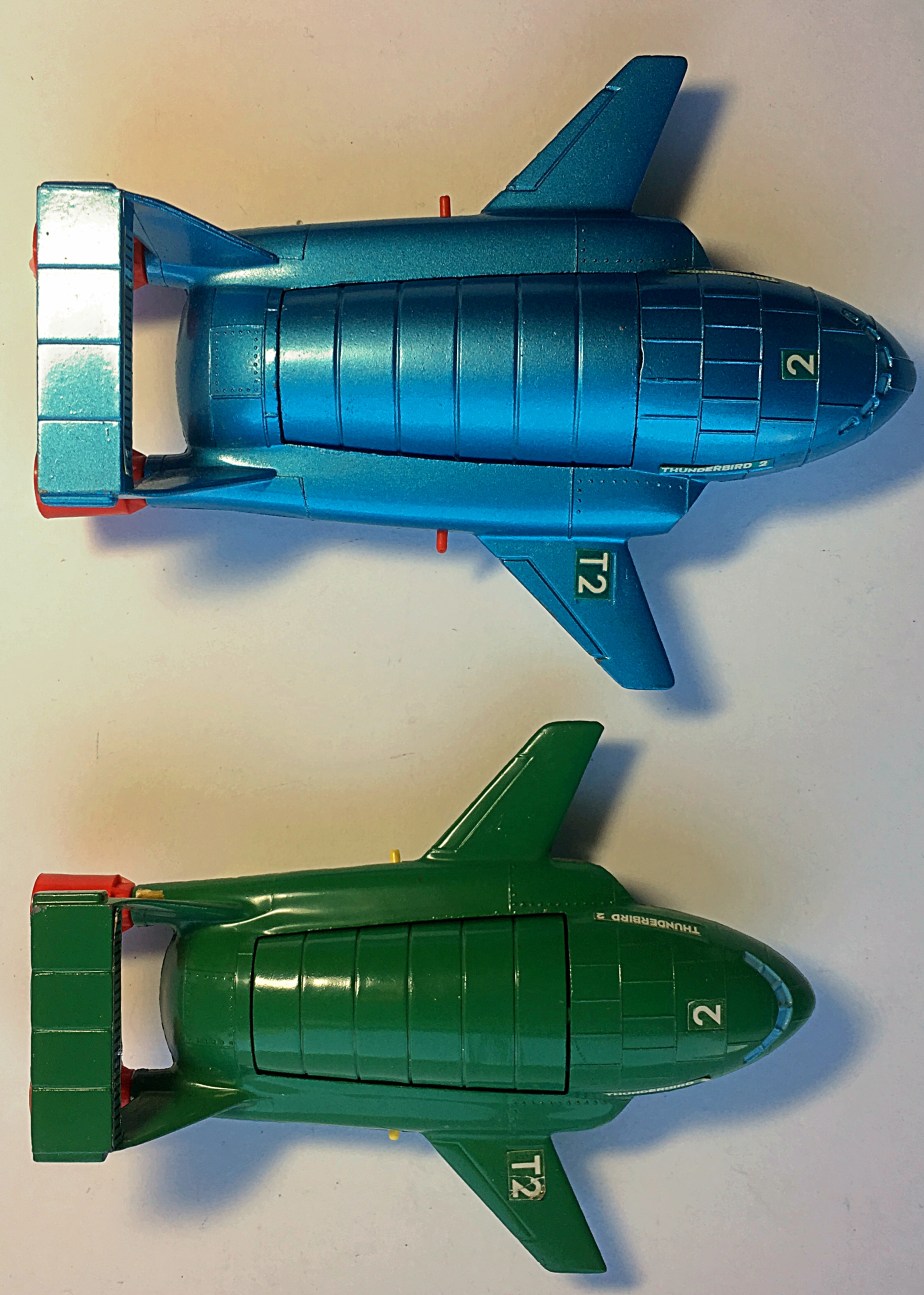 106: The legs were sturdier and could be red or yellow. The pod was larger although Thunderbird 4 was the same size as the one provided with 101. A larger centre lug was added to the pod door to ease opening and the rear of the main body had a small metal catch to help the pod stay in place rather than rely only on friction.
106: The legs were sturdier and could be red or yellow. The pod was larger although Thunderbird 4 was the same size as the one provided with 101. A larger centre lug was added to the pod door to ease opening and the rear of the main body had a small metal catch to help the pod stay in place rather than rely only on friction.

PROTOTYPES:
There is a rare yellow and black all plastic prototype version. Not a prototype for the original 106 Thunderbird 2 model but a cost saving experiment which never went into full production and only a handful of these were ever made. Note also both yellow and red legs were used. The plastic base was kept for the later versions of this model.
 Similar prototypes were also made in the same period for 103 Spectrum Patrol Car and 352 Ed Straker’s Car.
Similar prototypes were also made in the same period for 103 Spectrum Patrol Car and 352 Ed Straker’s Car.
BOXES:
The 106 T2 was released initially in a blue then yellow bubble pack. The final box was the window hanging type. The all-blue and blue and black models used the bubble packs
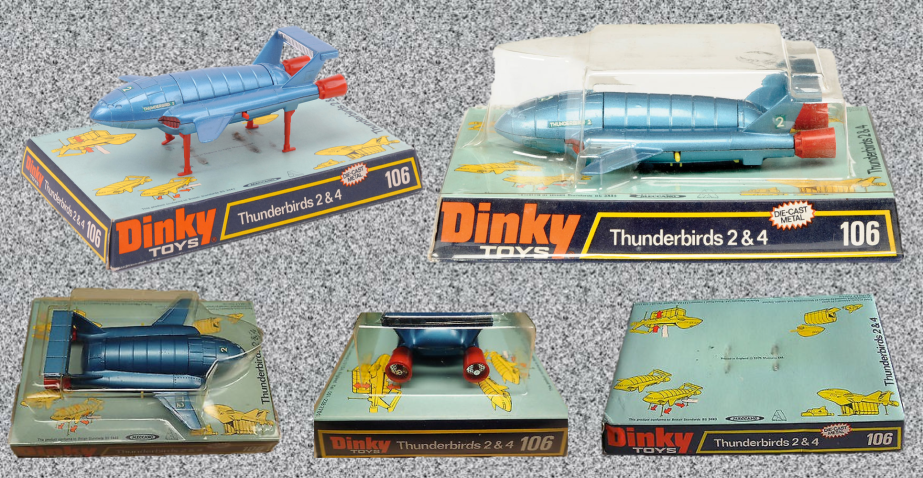
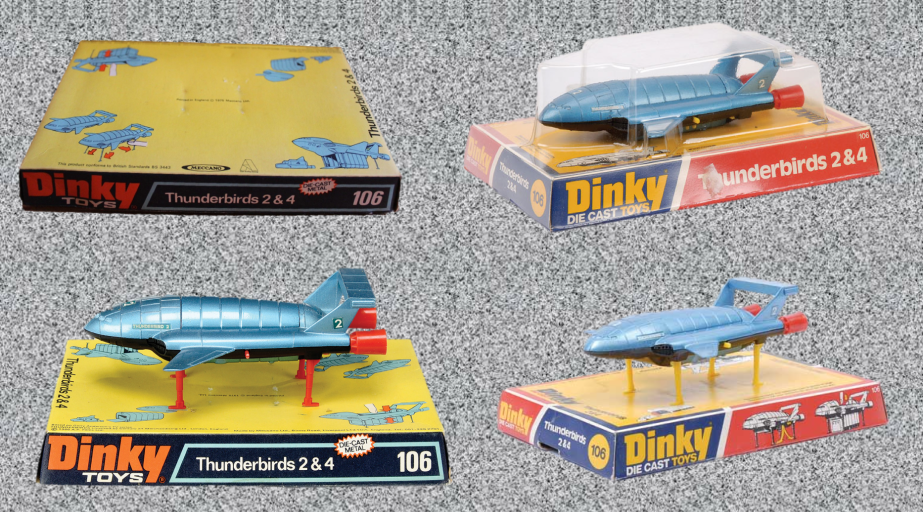
Around 1978 the window hanging box was introduced. The blue black and the blue white models used these boxes.

An USA export box also exists, shown here on a Dinky display stand from the late 1970’s.

CATALOGUES:

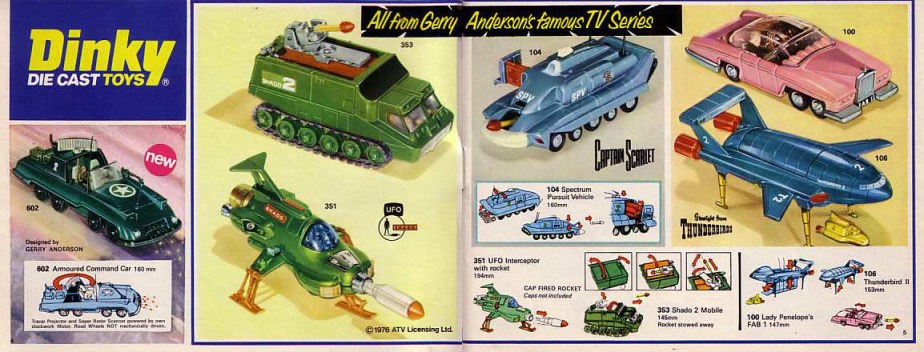
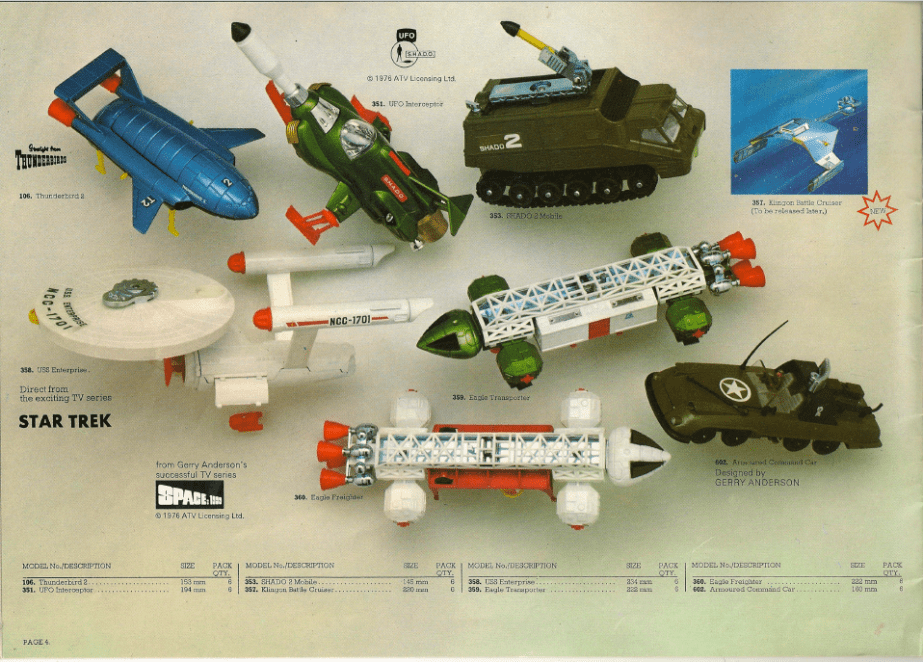



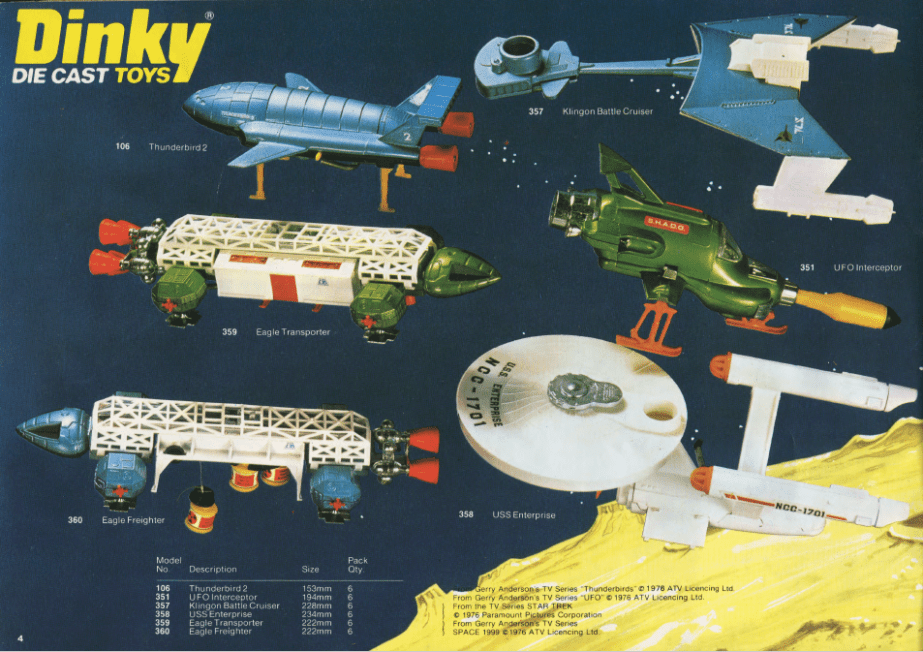
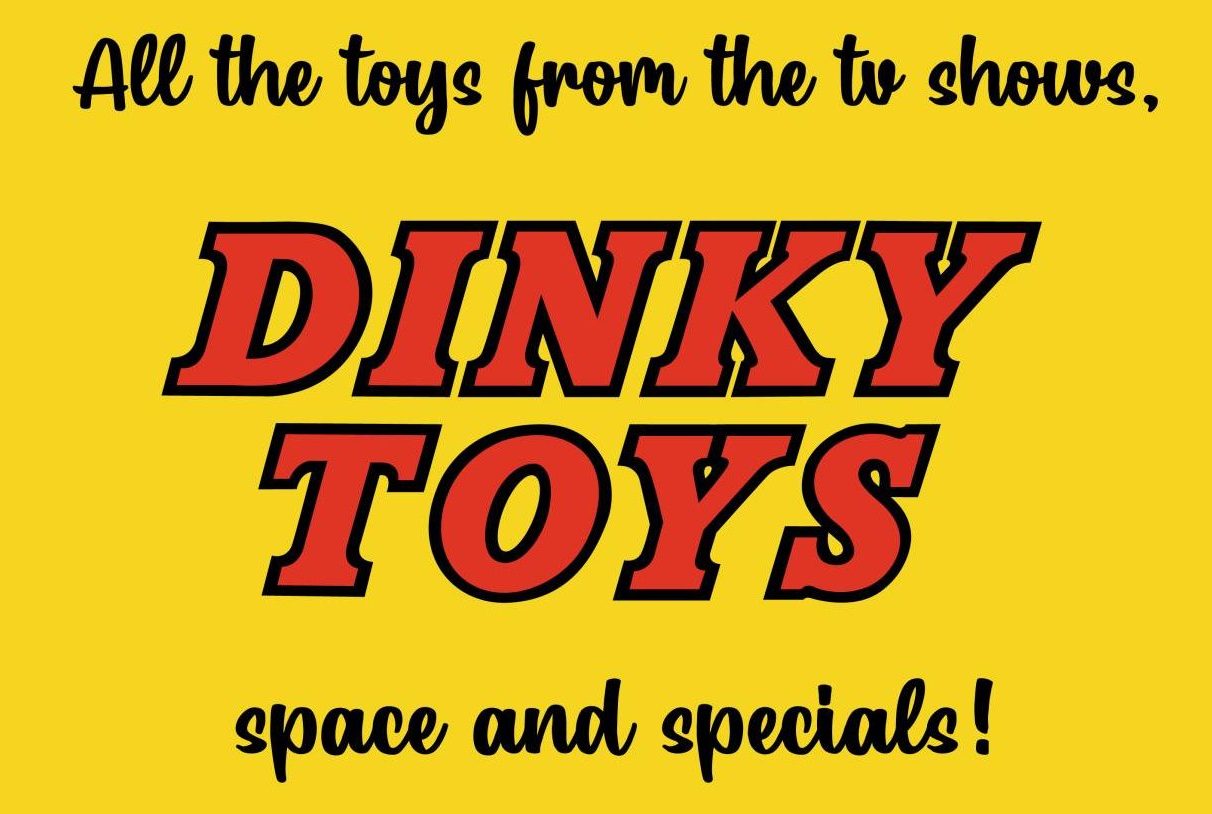
I bought a 106 Thunderbird 2 in about 1981 – it was the split blue/black version. Not long after getting it home, it was in bits, with the metal parts being introduced to some paint stripper. I matched the colour to a large picture of the original prop in a Japanese ‘Mook’ (Magazine/Book), which was a very high quality reproduction. Markings were Letraset rub-down ones, including a number on the pod door, and Thunderbird 4 was filled with model putty, and painted a better shade of yellow, with red accents, and a lightbar of styrene strip added. I kept the models until 1987, when I sold them to a friend, prior to moving to another part of England.
LikeLiked by 1 person
It’s odd about the ‘Children don’t like green toys’ – the Space: 1999 Eagle is green, because apparently: ‘Children don’t like white toys’. Hmm.
LikeLiked by 1 person
It’s nice to have found this. I’m in my mid thirties with older brothers now in their 50s.
As a young kid in the late 80s early 90s,I had a toybox full of my own matchbox/corgi sized cars and many handmedowns. One toy that always stuck in my mind was a fairly battered TB2 and until now, didn’t know why it was blue. I kind of missed thunderbirds due to my age so had no reason to think it wasn’t blue at first. Too young for the original and too old by the time it was on its 90s comeback and only then did I realise the colour was wrong.
If anyone’s interested, I’m 99% certain it had a white base with red legs. No door on the module by the time I had it nor any TB4, the 2 rollers squeaked quite loudly when rolled and 3 of the legs wouldn’t release properly with the side buttons- you had to pick them out before letting the spring take over.
LikeLike
Thanks for that memory – I had a box of diecast toys just like that which was then
passed on to my youngest brother. Not much survived but I still have a handful of these models and a lot of memories. Cheers Kevin
LikeLike
The leg thing has carried over to the 1992 Matchbox version – I got one from a car boot sale, to replace one that had gone crumbly with metal fatigue, and yes, only three legs came down when the buttons were pressed. It’s odd, as it is a totally different casting from the old Dinky one, but still has the same annoying little fault.
LikeLike
There was another variation. I got my blue/black/red leg version in (I think!) 1976. It has the yellow engine inserts (as per your picture of the white base version) and I’m pretty sure it was missing the air intake sticker as you mention.
LikeLike
Hi Doug, I have seen a black based 106 with the yellow/red inserts so its likely that these engine intakes started with this version. Missing decals seemed to be a feature of the later models as well, possibly because Dinky ran out and didn’t want to procure more or it was just a a lack of them during a short production run. Of course they could also have fallen off! Cheers Kevin
LikeLike
I’ll have to dig it out of storage, but memory says it was never there, and there’s no residue on that area, unlike the other spaces where the decals have worn off.
LikeLike
I’m 56 and just went through my garage last night, I have the blue version, got it for Christmas in 76 or 77, I have alot of my dinky toys still and I am flooded with memories!!!..I I believe I knew it was a great toy, I didn’t find the tools I had stored, but I found my treasure!!!
LikeLiked by 1 person
Hi Joel, Always nice finding the old Dinkys plus you didn’t have to do the DIY – looks like a win win! Cheers Kevin
LikeLike
Hi, good information here.
I have a Blue / black base / yellow leg version.
It came with a bonus man on a an inflatable.
Well loved but all still working well
LikeLike
Hi Andrew, Thanks for the information. Did you purchase from new the model with the man and boat? How was it packaged? And if you could you share a picture of these that would be brilliant! Cheers, Kevin
LikeLike
Using that logic, I am surprised they didn;t do a blue FAB1, because boys wouldn;t want a pink car in their collection. Glad my TB2 is green.
LikeLike
Hi Keith, I tend to agree with you on this. When Thunderbirds started it was shown in black and white so the colour of vehicles was not as important. However FAB1 being pink was an intrinsic part of its identity. There were colour variations but these were seemingly in very short production runs. Cheers Kevin
LikeLike